Zexue He
WildFeedback: Aligning LLMs With In-situ User Interactions And Feedback
Aug 28, 2024



Abstract:As large language models (LLMs) continue to advance, aligning these models with human preferences has emerged as a critical challenge. Traditional alignment methods, relying on human or LLM annotated datasets, are limited by their resource-intensive nature, inherent subjectivity, and the risk of feedback loops that amplify model biases. To overcome these limitations, we introduce WildFeedback, a novel framework that leverages real-time, in-situ user interactions to create preference datasets that more accurately reflect authentic human values. WildFeedback operates through a three-step process: feedback signal identification, preference data construction, and user-guided evaluation. We applied this framework to a large corpus of user-LLM conversations, resulting in a rich preference dataset that reflects genuine user preferences. This dataset captures the nuances of user preferences by identifying and classifying feedback signals within natural conversations, thereby enabling the construction of more representative and context-sensitive alignment data. Our extensive experiments demonstrate that LLMs fine-tuned on WildFeedback exhibit significantly improved alignment with user preferences, as evidenced by both traditional benchmarks and our proposed user-guided evaluation. By incorporating real-time feedback from actual users, WildFeedback addresses the scalability, subjectivity, and bias challenges that plague existing approaches, marking a significant step toward developing LLMs that are more responsive to the diverse and evolving needs of their users. In summary, WildFeedback offers a robust, scalable solution for aligning LLMs with true human values, setting a new standard for the development and evaluation of user-centric language models.
Large Scale Knowledge Washing
May 28, 2024Abstract:Large language models show impressive abilities in memorizing world knowledge, which leads to concerns regarding memorization of private information, toxic or sensitive knowledge, and copyrighted content. We introduce the problem of Large Scale Knowledge Washing, focusing on unlearning an extensive amount of factual knowledge. Previous unlearning methods usually define the reverse loss and update the model via backpropagation, which may affect the model's fluency and reasoning ability or even destroy the model due to extensive training with the reverse loss. Existing works introduce additional data from downstream tasks to prevent the model from losing capabilities, which requires downstream task awareness. Controlling the tradeoff of unlearning and maintaining existing capabilities is also challenging. To this end, we propose LAW (Large Scale Washing) to update the MLP layers in decoder-only large language models to perform knowledge washing, as inspired by model editing methods and based on the hypothesis that knowledge and reasoning are disentanglable. We derive a new objective with the knowledge to be unlearned to update the weights of certain MLP layers. Experimental results demonstrate the effectiveness of LAW in forgetting target knowledge while maintaining reasoning ability. The code will be open-sourced at https://github.com/wangyu-ustc/LargeScaleWashing.
Cognitive Bias in High-Stakes Decision-Making with LLMs
Feb 25, 2024



Abstract:Large language models (LLMs) offer significant potential as tools to support an expanding range of decision-making tasks. However, given their training on human (created) data, LLMs can inherit both societal biases against protected groups, as well as be subject to cognitive bias. Such human-like bias can impede fair and explainable decisions made with LLM assistance. Our work introduces BiasBuster, a framework designed to uncover, evaluate, and mitigate cognitive bias in LLMs, particularly in high-stakes decision-making tasks. Inspired by prior research in psychology and cognitive sciences, we develop a dataset containing 16,800 prompts to evaluate different cognitive biases (e.g., prompt-induced, sequential, inherent). We test various bias mitigation strategies, amidst proposing a novel method using LLMs to debias their own prompts. Our analysis provides a comprehensive picture on the presence and effects of cognitive bias across different commercial and open-source models. We demonstrate that our self-help debiasing effectively mitigate cognitive bias without having to manually craft examples for each bias type.
CAMELoT: Towards Large Language Models with Training-Free Consolidated Associative Memory
Feb 21, 2024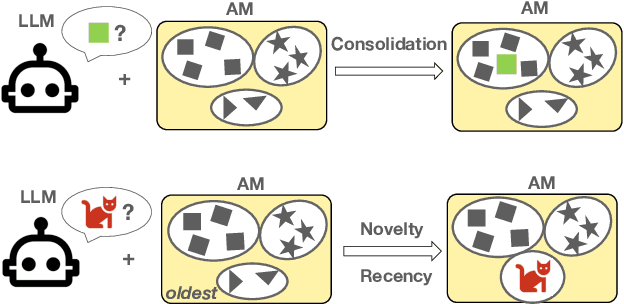
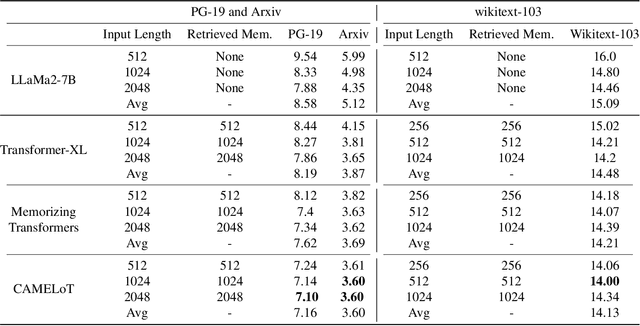
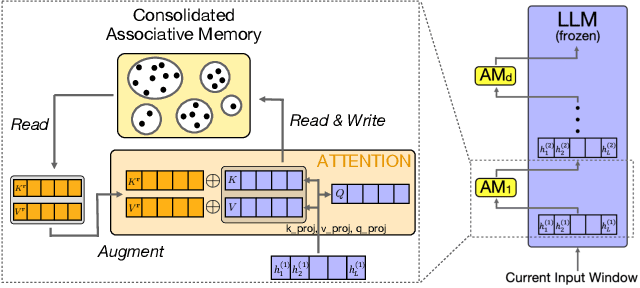
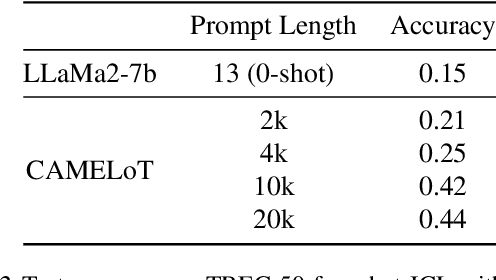
Abstract:Large Language Models (LLMs) struggle to handle long input sequences due to high memory and runtime costs. Memory-augmented models have emerged as a promising solution to this problem, but current methods are hindered by limited memory capacity and require costly re-training to integrate with a new LLM. In this work, we introduce an associative memory module which can be coupled to any pre-trained (frozen) attention-based LLM without re-training, enabling it to handle arbitrarily long input sequences. Unlike previous methods, our associative memory module consolidates representations of individual tokens into a non-parametric distribution model, dynamically managed by properly balancing the novelty and recency of the incoming data. By retrieving information from this consolidated associative memory, the base LLM can achieve significant (up to 29.7% on Arxiv) perplexity reduction in long-context modeling compared to other baselines evaluated on standard benchmarks. This architecture, which we call CAMELoT (Consolidated Associative Memory Enhanced Long Transformer), demonstrates superior performance even with a tiny context window of 128 tokens, and also enables improved in-context learning with a much larger set of demonstrations.
LVCHAT: Facilitating Long Video Comprehension
Feb 19, 2024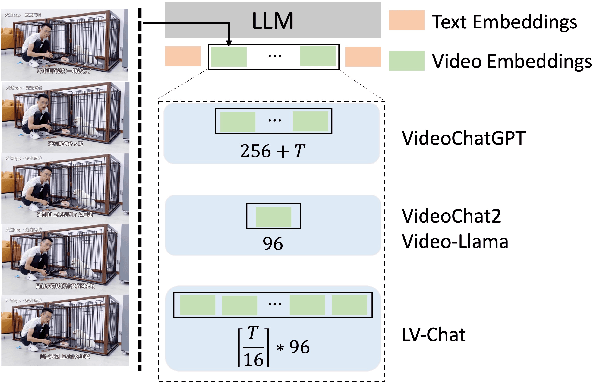

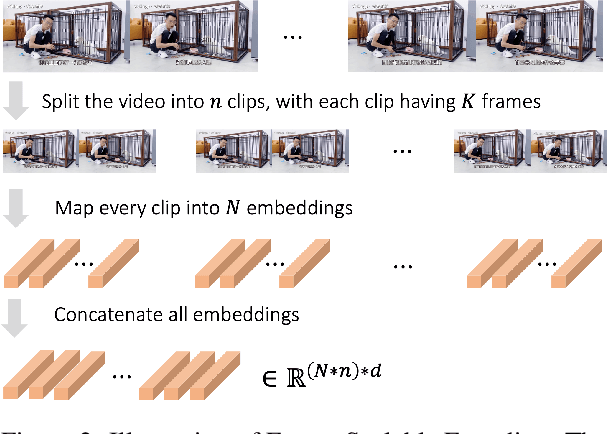

Abstract:Enabling large language models (LLMs) to read videos is vital for multimodal LLMs. Existing works show promise on short videos whereas long video (longer than e.g.~1 minute) comprehension remains challenging. The major problem lies in the over-compression of videos, i.e., the encoded video representations are not enough to represent the whole video. To address this issue, we propose Long Video Chat (LVChat), where Frame-Scalable Encoding (FSE) is introduced to dynamically adjust the number of embeddings in alignment with the duration of the video to ensure long videos are not overly compressed into a few embeddings. To deal with long videos whose length is beyond videos seen during training, we propose Interleaved Frame Encoding (IFE), repeating positional embedding and interleaving multiple groups of videos to enable long video input, avoiding performance degradation due to overly long videos. Experimental results show that LVChat significantly outperforms existing methods by up to 27\% in accuracy on long-video QA datasets and long-video captioning benchmarks. Our code is published at https://github.com/wangyu-ustc/LVChat.
InfoRank: Unbiased Learning-to-Rank via Conditional Mutual Information Minimization
Jan 23, 2024



Abstract:Ranking items regarding individual user interests is a core technique of multiple downstream tasks such as recommender systems. Learning such a personalized ranker typically relies on the implicit feedback from users' past click-through behaviors. However, collected feedback is biased toward previously highly-ranked items and directly learning from it would result in a "rich-get-richer" phenomenon. In this paper, we propose a simple yet sufficient unbiased learning-to-rank paradigm named InfoRank that aims to simultaneously address both position and popularity biases. We begin by consolidating the impacts of those biases into a single observation factor, thereby providing a unified approach to addressing bias-related issues. Subsequently, we minimize the mutual information between the observation estimation and the relevance estimation conditioned on the input features. By doing so, our relevance estimation can be proved to be free of bias. To implement InfoRank, we first incorporate an attention mechanism to capture latent correlations within user-item features, thereby generating estimations of observation and relevance. We then introduce a regularization term, grounded in conditional mutual information, to promote conditional independence between relevance estimation and observation estimation. Experimental evaluations conducted across three extensive recommendation and search datasets reveal that InfoRank learns more precise and unbiased ranking strategies.
Deciphering Compatibility Relationships with Textual Descriptions via Extraction and Explanation
Dec 17, 2023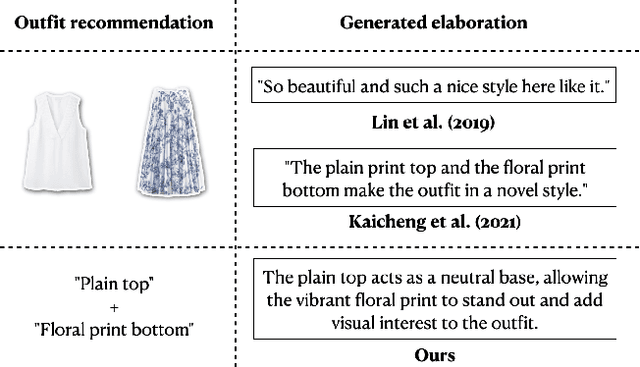
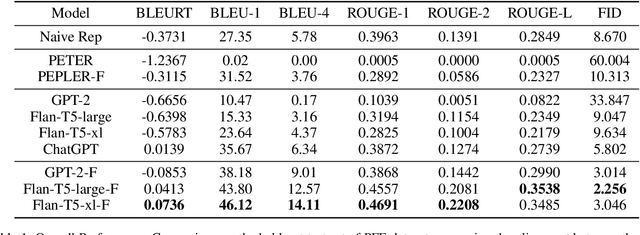
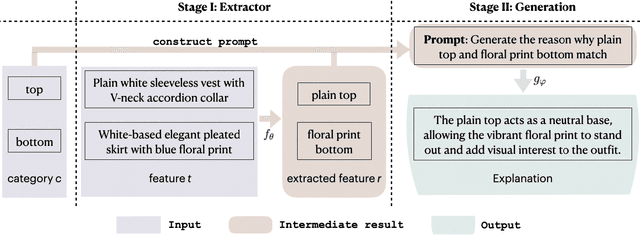

Abstract:Understanding and accurately explaining compatibility relationships between fashion items is a challenging problem in the burgeoning domain of AI-driven outfit recommendations. Present models, while making strides in this area, still occasionally fall short, offering explanations that can be elementary and repetitive. This work aims to address these shortcomings by introducing the Pair Fashion Explanation (PFE) dataset, a unique resource that has been curated to illuminate these compatibility relationships. Furthermore, we propose an innovative two-stage pipeline model that leverages this dataset. This fine-tuning allows the model to generate explanations that convey the compatibility relationships between items. Our experiments showcase the model's potential in crafting descriptions that are knowledgeable, aligned with ground-truth matching correlations, and that produce understandable and informative descriptions, as assessed by both automatic metrics and human evaluation. Our code and data are released at https://github.com/wangyu-ustc/PairFashionExplanation
MedEval: A Multi-Level, Multi-Task, and Multi-Domain Medical Benchmark for Language Model Evaluation
Oct 27, 2023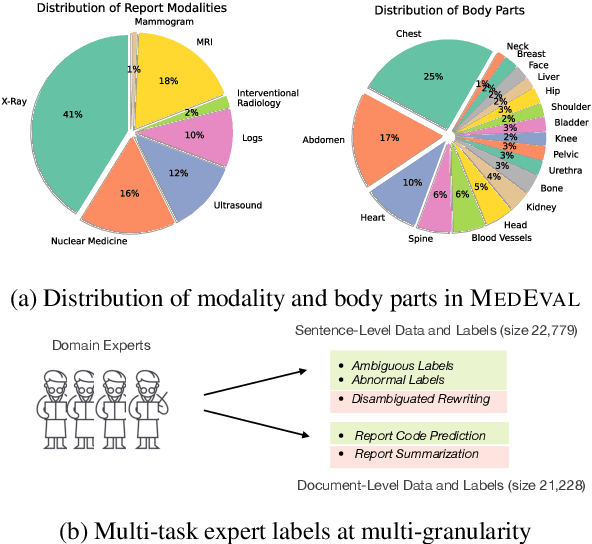
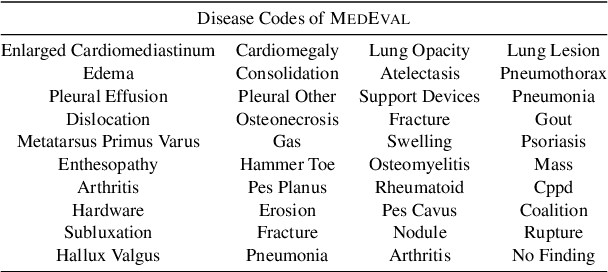
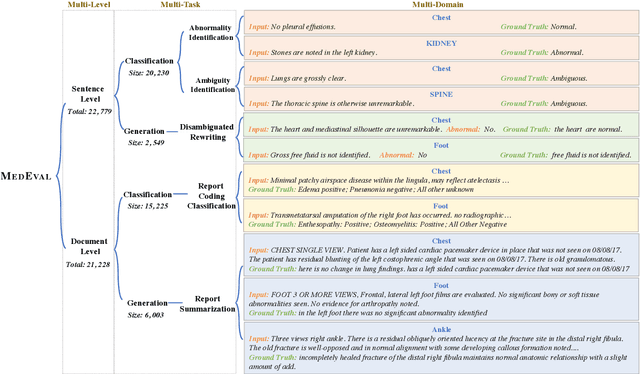
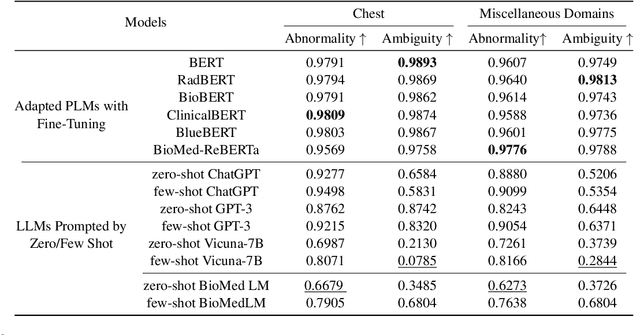
Abstract:Curated datasets for healthcare are often limited due to the need of human annotations from experts. In this paper, we present MedEval, a multi-level, multi-task, and multi-domain medical benchmark to facilitate the development of language models for healthcare. MedEval is comprehensive and consists of data from several healthcare systems and spans 35 human body regions from 8 examination modalities. With 22,779 collected sentences and 21,228 reports, we provide expert annotations at multiple levels, offering a granular potential usage of the data and supporting a wide range of tasks. Moreover, we systematically evaluated 10 generic and domain-specific language models under zero-shot and finetuning settings, from domain-adapted baselines in healthcare to general-purposed state-of-the-art large language models (e.g., ChatGPT). Our evaluations reveal varying effectiveness of the two categories of language models across different tasks, from which we notice the importance of instruction tuning for few-shot usage of large language models. Our investigation paves the way toward benchmarking language models for healthcare and provides valuable insights into the strengths and limitations of adopting large language models in medical domains, informing their practical applications and future advancements.
Farzi Data: Autoregressive Data Distillation
Oct 15, 2023



Abstract:We study data distillation for auto-regressive machine learning tasks, where the input and output have a strict left-to-right causal structure. More specifically, we propose Farzi, which summarizes an event sequence dataset into a small number of synthetic sequences -- Farzi Data -- which are optimized to maintain (if not improve) model performance compared to training on the full dataset. Under the hood, Farzi conducts memory-efficient data distillation by (i) deriving efficient reverse-mode differentiation of the Adam optimizer by leveraging Hessian-Vector Products; and (ii) factorizing the high-dimensional discrete event-space into a latent-space which provably promotes implicit regularization. Empirically, for sequential recommendation and language modeling tasks, we are able to achieve 98-120% of downstream full-data performance when training state-of-the-art models on Farzi Data of size as little as 0.1% of the original dataset. Notably, being able to train better models with significantly less data sheds light on the design of future large auto-regressive models, and opens up new opportunities to further scale up model and data sizes.
Robust and Interpretable Medical Image Classifiers via Concept Bottleneck Models
Oct 04, 2023



Abstract:Medical image classification is a critical problem for healthcare, with the potential to alleviate the workload of doctors and facilitate diagnoses of patients. However, two challenges arise when deploying deep learning models to real-world healthcare applications. First, neural models tend to learn spurious correlations instead of desired features, which could fall short when generalizing to new domains (e.g., patients with different ages). Second, these black-box models lack interpretability. When making diagnostic predictions, it is important to understand why a model makes a decision for trustworthy and safety considerations. In this paper, to address these two limitations, we propose a new paradigm to build robust and interpretable medical image classifiers with natural language concepts. Specifically, we first query clinical concepts from GPT-4, then transform latent image features into explicit concepts with a vision-language model. We systematically evaluate our method on eight medical image classification datasets to verify its effectiveness. On challenging datasets with strong confounding factors, our method can mitigate spurious correlations thus substantially outperform standard visual encoders and other baselines. Finally, we show how classification with a small number of concepts brings a level of interpretability for understanding model decisions through case studies in real medical data.
 Add to Chrome
Add to Chrome Add to Firefox
Add to Firefox Add to Edge
Add to Edge